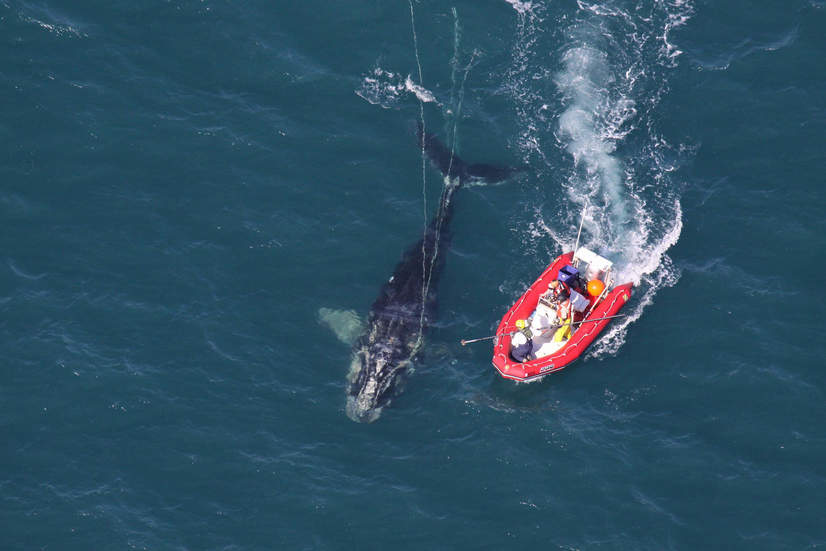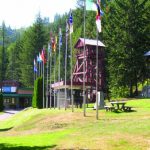Op/Ed: We Need to Stop Killing Endangered Right Whales
Article by James Wilt, first published in DeSmog Canada.
The summer of 2017 was an extraordinarily deadly one for North Atlantic right whales, a species already hovering on the brink of extinction.
Investigations are ongoing into the cause of death of 15 right whales off the Atlantic Coast of Canada and the U.S., although it’s not too soon to point the finger at human activity, Megan Leslie, vice president of oceans for WWF-Canada, told DeSmog Canada.
“I’ve been frustrated by reports that we don’t know what’s killing these whales,” Leslie said.
“We do. We know it’s human activity. There haven’t been necropsies on all of the whales, but the ones where there have been it’s clearly been blunt force trauma from ship strikes and entanglement in fishing gear.”
As widely reported, a bizarre spate of ten whales were found dead in the Gulf of St. Lawrence in June and July. Since then another five whales have been found floating dead or washed ashore in Canada and the U.S.
There are an estimated 500 right whales, which can grow to be 50 feet long, left in the entire world.
That means the deaths represent three per cent of the global population killed in only one summer.
It’s completely unprecedented.
“Immediate measures” needed to save species
“It is hard to overstate how serious this problem is,” Leslie, who was the former federal NDP environment critic and MP for Halifax, said.
“People have been looking at how to rebuild this population and now with these deaths I’m quite worried that it’s no longer a discussion about how to rebuild the population, but even how to just save it.”
The federal government has introduced some new rules in response, including closing a snow crab fishery, continuing surveillance flights and implemented a temporary mandatory slow-down in the area by about one-third of average speeds.
On Aug. 30, Minister of Fisheries and Oceans Dominic LeBlanc announced the government is developing a new set of rules for commercial fishing gear and practices to help prevent deadly entanglements.
But conservationists fear it might not be enough.
“These immediate measures are desperately needed,” said Alexandra Barron, an ocean conservation manager for the Canadian Parks and Wilderness Society, in an interview with DeSmog Canada.
“However, our position is we need to start managing these waters much more proactively and considering the needs of endangered whales.”
Over 70 Percent of Right Whales Bear Scars from Fishing Entanglements
Right whales have been killed before in Canadian waters, but the average number of deaths was only 3.8 per year prior to 2017.
That means there’s been a potential tripling of whale casualties in a single year, a huge blow for a population that only recently rebounded from a dangerous low of under 300 whales in the 1990s.
A spokesperson for the Department of Fisheries and Oceans (DFO) wrote in an email that it takes scientists between six and eight weeks to receive complete results on cause of death for the whales following the necropsies and samples.
Leslie said one of the whales had been caught in fishing gear for two weeks before it died.
More than 70 per cent of North Atlantic right whales actually bear scars from such encounters.
However, due to the tragic death of a member of the Campobello Whale Rescue Team in July 2017 during a disentanglement, the DFO has temporarily suspended all disentanglement operations.
The WWF notes that between 1970 and 2006, humans were responsible of 48 per cent of the deaths of right whales, mostly due to ship strikes or entanglements.
Many Critical Habitats Still Unexplored
However, it’s less known why the whales have moved from the Bay of Fundy or off the coast of Nova Scotia to the Gulf of St. Lawrence, where there’s considerably higher shipping traffic and more fishing gear.
There are some hypotheses around impacts of climate change and water temperatures, with the whales potentially following food sources. However, Barron said that right whales have been in the area and used the Gulf of St. Lawrence prior to this season. It’s difficult to draw any real conclusions without comprehensive coast-wide surveying, she said, in order to find out exactly where the whales might go.
Currently, Canada only has two designated areas of critical right whale habitat: the Grand Manan Basin and Roseway Basin. Barron said that by contrast, the U.S. has effectively designated their entire shelf waters throughout Maine and other northern states as critical habitat.
“We’re likely to see shifts in their movements in future years,” she said. “And we need to start mapping these areas of use and planning for that in the future.”
Between August 23 and 30, an expedition led by Oceana Canada used advanced exploration technology to survey much of the Gulf of St. Lawrence.
Robert Rangeley, director of science at Oceana Canada and key planner of the expedition, said in an interview with DeSmog Canada that much of the region is still fairly uncharted, pointing to the American Bank (located just off the Gaspé Peninsula in the Quebec portion of the Gulf of St. Lawrence).
“It’s got this official designation as an area of interest for a Marine Protected Area,” he said. “But it’s never been explored. None of these areas have been explored with cameras. We don’t really know what’s down there.”
Such a current lack of knowledge obviously impedes the ability for the federal government to craft appropriate regulations to ensure the survival of right whales and other marine mammals.
Network of Marine Protected Areas Could Help Save Right Whales
And that’s where marine protected areas (MPAs) are supposed to come in.
As previously reported by DeSmog Canada, the federal government is aiming to protect 10 per cent of marine areas by 2020. However, proposed regulations for the Laurentian Channel MPA in the Gulf of St. Lawrence are under serious fire as they currently allow for potential offshore oil and gas exploration and drilling.
Conservationists suggest that a critical way to protect right whales is via the MPA network.
“These processes have been to this point very, very slow,” Barron said. “We need to start moving more quickly on these processes and identifying those potential areas where we may see whales: even if we’re not seeing them this year, that might be where they go next year, and we need to start making sure those sites are properly protected for the whales long into the future.”
Allowing oil and gas activities in the region would result in a series of catastrophic impacts, including increased marine traffic and chances of ship strikes, destruction of zooplankton and other food sources, contamination of food webs with toxic waste and a much higher chance of oil spills.
Unless the federal government protects such areas with strict regulations, there’s no real guarantee that this year’s death toll will be anomalous in the future.
“The deck is stacked against these whales,” Leslie concluded. “There’s so much coming at them, we’ve just got to figure out a way to help them survive.”
Article by James Wilt, first published in DeSmog Canada.
Related Articles:
Industry Sways Feds to Allow Offshore Drilling in Laurentian Channel Marine Protected Area
Canada Has Three Years to Increase Protected Areas by 60% And, Um, It’s Not Going to Be Easy























